Chuan Xu
Reconciling Communication Compression and Byzantine-Robustness in Distributed Learning
Aug 23, 2025Abstract:Distributed learning (DL) enables scalable model training over decentralized data, but remains challenged by Byzantine faults and high communication costs. While both issues have been studied extensively in isolation, their interaction is less explored. Prior work shows that naively combining communication compression with Byzantine-robust aggregation degrades resilience to faulty nodes (or workers). The state-of-the-art algorithm, namely Byz-DASHA-PAGE [29], makes use of the momentum variance reduction scheme to mitigate the detrimental impact of compression noise on Byzantine-robustness. We propose a new algorithm, named RoSDHB, that integrates the classic Polyak's momentum with a new coordinated compression mechanism. We show that RoSDHB performs comparably to Byz-DASHA-PAGE under the standard (G, B)-gradient dissimilarity heterogeneity model, while it relies on fewer assumptions. In particular, we only assume Lipschitz smoothness of the average loss function of the honest workers, in contrast to [29]that additionally assumes a special smoothness of bounded global Hessian variance. Empirical results on benchmark image classification task show that RoSDHB achieves strong robustness with significant communication savings.
The Cell Ontology in the age of single-cell omics
Jun 10, 2025Abstract:Single-cell omics technologies have transformed our understanding of cellular diversity by enabling high-resolution profiling of individual cells. However, the unprecedented scale and heterogeneity of these datasets demand robust frameworks for data integration and annotation. The Cell Ontology (CL) has emerged as a pivotal resource for achieving FAIR (Findable, Accessible, Interoperable, and Reusable) data principles by providing standardized, species-agnostic terms for canonical cell types - forming a core component of a wide range of platforms and tools. In this paper, we describe the wide variety of uses of CL in these platforms and tools and detail ongoing work to improve and extend CL content including the addition of transcriptomically defined types, working closely with major atlasing efforts including the Human Cell Atlas and the Brain Initiative Cell Atlas Network to support their needs. We cover the challenges and future plans for harmonising classical and transcriptomic cell type definitions, integrating markers and using Large Language Models (LLMs) to improve content and efficiency of CL workflows.
mmRAG: A Modular Benchmark for Retrieval-Augmented Generation over Text, Tables, and Knowledge Graphs
May 16, 2025Abstract:Retrieval-Augmented Generation (RAG) has emerged as a powerful paradigm for enhancing the capabilities of large language models. However, existing RAG evaluation predominantly focuses on text retrieval and relies on opaque, end-to-end assessments of generated outputs. To address these limitations, we introduce mmRAG, a modular benchmark designed for evaluating multi-modal RAG systems. Our benchmark integrates queries from six diverse question-answering datasets spanning text, tables, and knowledge graphs, which we uniformly convert into retrievable documents. To enable direct, granular evaluation of individual RAG components -- such as the accuracy of retrieval and query routing -- beyond end-to-end generation quality, we follow standard information retrieval procedures to annotate document relevance and derive dataset relevance. We establish baseline performance by evaluating a wide range of RAG implementations on mmRAG.
Cutting Through Privacy: A Hyperplane-Based Data Reconstruction Attack in Federated Learning
May 15, 2025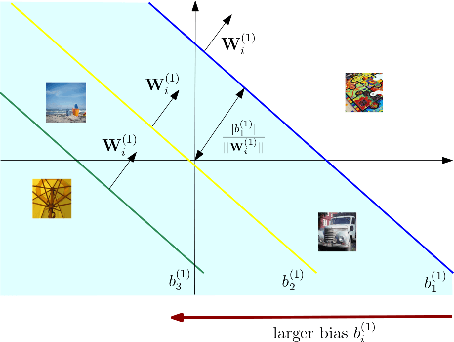
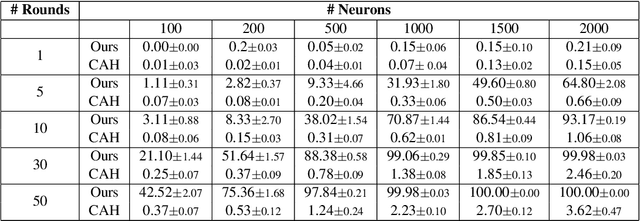
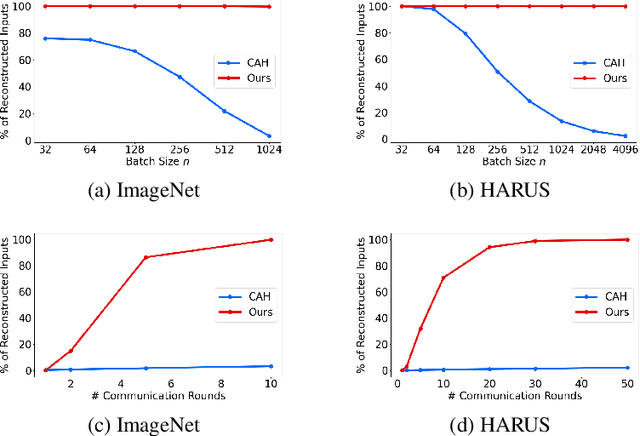
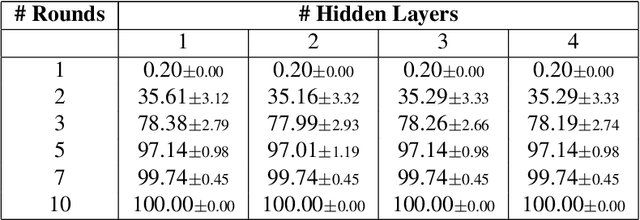
Abstract:Federated Learning (FL) enables collaborative training of machine learning models across distributed clients without sharing raw data, ostensibly preserving data privacy. Nevertheless, recent studies have revealed critical vulnerabilities in FL, showing that a malicious central server can manipulate model updates to reconstruct clients' private training data. Existing data reconstruction attacks have important limitations: they often rely on assumptions about the clients' data distribution or their efficiency significantly degrades when batch sizes exceed just a few tens of samples. In this work, we introduce a novel data reconstruction attack that overcomes these limitations. Our method leverages a new geometric perspective on fully connected layers to craft malicious model parameters, enabling the perfect recovery of arbitrarily large data batches in classification tasks without any prior knowledge of clients' data. Through extensive experiments on both image and tabular datasets, we demonstrate that our attack outperforms existing methods and achieves perfect reconstruction of data batches two orders of magnitude larger than the state of the art.
Attribute Inference Attacks for Federated Regression Tasks
Nov 19, 2024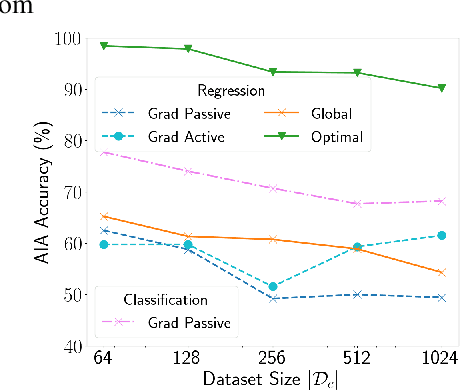
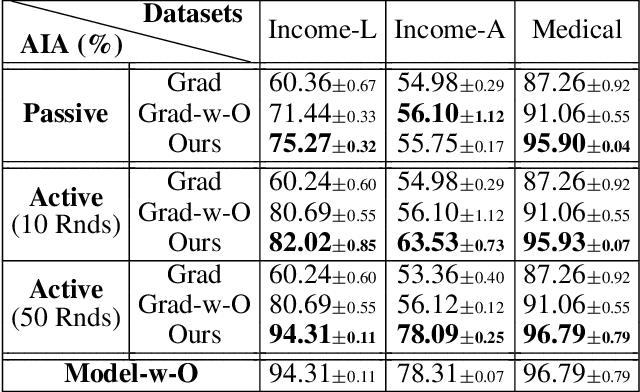
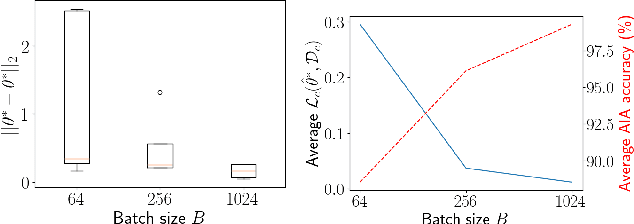
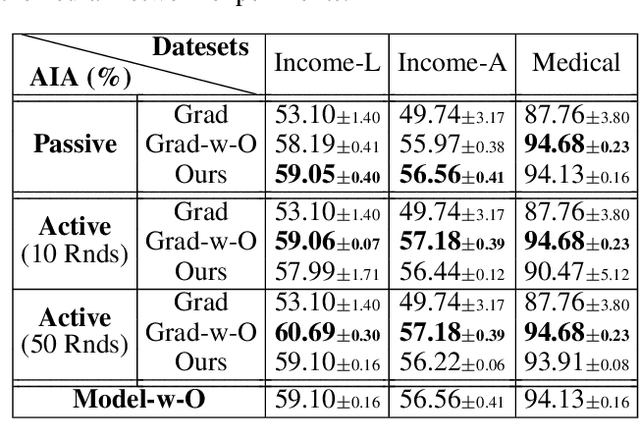
Abstract:Federated Learning (FL) enables multiple clients, such as mobile phones and IoT devices, to collaboratively train a global machine learning model while keeping their data localized. However, recent studies have revealed that the training phase of FL is vulnerable to reconstruction attacks, such as attribute inference attacks (AIA), where adversaries exploit exchanged messages and auxiliary public information to uncover sensitive attributes of targeted clients. While these attacks have been extensively studied in the context of classification tasks, their impact on regression tasks remains largely unexplored. In this paper, we address this gap by proposing novel model-based AIAs specifically designed for regression tasks in FL environments. Our approach considers scenarios where adversaries can either eavesdrop on exchanged messages or directly interfere with the training process. We benchmark our proposed attacks against state-of-the-art methods using real-world datasets. The results demonstrate a significant increase in reconstruction accuracy, particularly in heterogeneous client datasets, a common scenario in FL. The efficacy of our model-based AIAs makes them better candidates for empirically quantifying privacy leakage for federated regression tasks.
Federated Learning for Cooperative Inference Systems: The Case of Early Exit Networks
May 07, 2024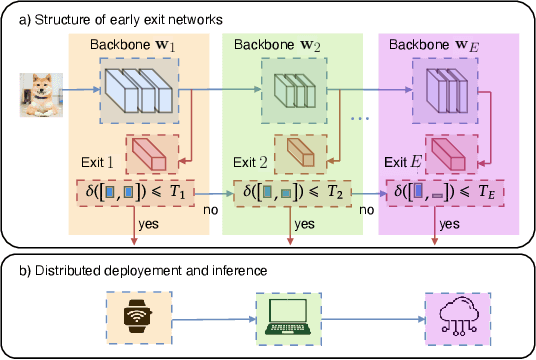

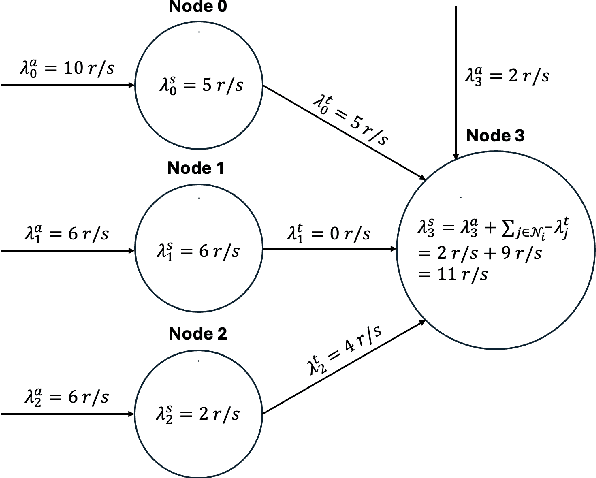

Abstract:As Internet of Things (IoT) technology advances, end devices like sensors and smartphones are progressively equipped with AI models tailored to their local memory and computational constraints. Local inference reduces communication costs and latency; however, these smaller models typically underperform compared to more sophisticated models deployed on edge servers or in the cloud. Cooperative Inference Systems (CISs) address this performance trade-off by enabling smaller devices to offload part of their inference tasks to more capable devices. These systems often deploy hierarchical models that share numerous parameters, exemplified by Deep Neural Networks (DNNs) that utilize strategies like early exits or ordered dropout. In such instances, Federated Learning (FL) may be employed to jointly train the models within a CIS. Yet, traditional training methods have overlooked the operational dynamics of CISs during inference, particularly the potential high heterogeneity in serving rates across clients. To address this gap, we propose a novel FL approach designed explicitly for use in CISs that accounts for these variations in serving rates. Our framework not only offers rigorous theoretical guarantees, but also surpasses state-of-the-art (SOTA) training algorithms for CISs, especially in scenarios where inference request rates or data availability are uneven among clients.
A Cautionary Tale: On the Role of Reference Data in Empirical Privacy Defenses
Oct 18, 2023



Abstract:Within the realm of privacy-preserving machine learning, empirical privacy defenses have been proposed as a solution to achieve satisfactory levels of training data privacy without a significant drop in model utility. Most existing defenses against membership inference attacks assume access to reference data, defined as an additional dataset coming from the same (or a similar) underlying distribution as training data. Despite the common use of reference data, previous works are notably reticent about defining and evaluating reference data privacy. As gains in model utility and/or training data privacy may come at the expense of reference data privacy, it is essential that all three aspects are duly considered. In this paper, we first examine the availability of reference data and its privacy treatment in previous works and demonstrate its necessity for fairly comparing defenses. Second, we propose a baseline defense that enables the utility-privacy tradeoff with respect to both training and reference data to be easily understood. Our method is formulated as an empirical risk minimization with a constraint on the generalization error, which, in practice, can be evaluated as a weighted empirical risk minimization (WERM) over the training and reference datasets. Although we conceived of WERM as a simple baseline, our experiments show that, surprisingly, it outperforms the most well-studied and current state-of-the-art empirical privacy defenses using reference data for nearly all relative privacy levels of reference and training data. Our investigation also reveals that these existing methods are unable to effectively trade off reference data privacy for model utility and/or training data privacy. Overall, our work highlights the need for a proper evaluation of the triad model utility / training data privacy / reference data privacy when comparing privacy defenses.
Local Model Reconstruction Attacks in Federated Learning and their Uses
Oct 28, 2022Abstract:In this paper, we initiate the study of local model reconstruction attacks for federated learning, where a honest-but-curious adversary eavesdrops the messages exchanged between a targeted client and the server, and then reconstructs the local/personalized model of the victim. The local model reconstruction attack allows the adversary to trigger other classical attacks in a more effective way, since the local model only depends on the client's data and can leak more private information than the global model learned by the server. Additionally, we propose a novel model-based attribute inference attack in federated learning leveraging the local model reconstruction attack. We provide an analytical lower-bound for this attribute inference attack. Empirical results using real world datasets confirm that our local reconstruction attack works well for both regression and classification tasks. Moreover, we benchmark our novel attribute inference attack against the state-of-the-art attacks in federated learning. Our attack results in higher reconstruction accuracy especially when the clients' datasets are heterogeneous. Our work provides a new angle for designing powerful and explainable attacks to effectively quantify the privacy risk in FL.
Efficient passive membership inference attack in federated learning
Oct 31, 2021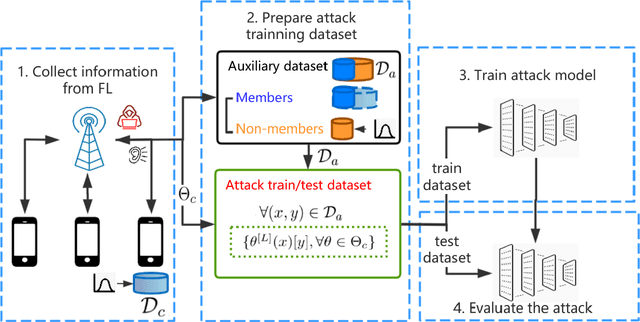


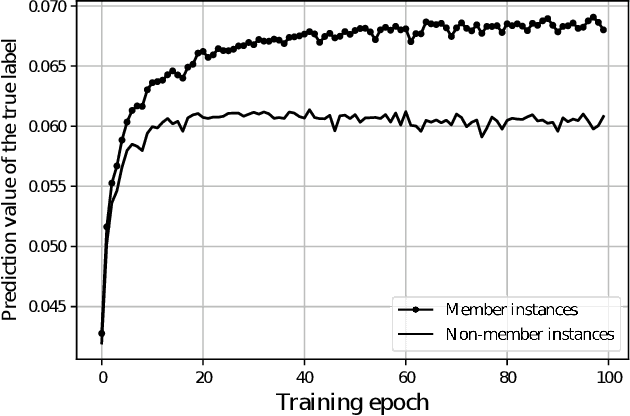
Abstract:In cross-device federated learning (FL) setting, clients such as mobiles cooperate with the server to train a global machine learning model, while maintaining their data locally. However, recent work shows that client's private information can still be disclosed to an adversary who just eavesdrops the messages exchanged between the client and the server. For example, the adversary can infer whether the client owns a specific data instance, which is called a passive membership inference attack. In this paper, we propose a new passive inference attack that requires much less computation power and memory than existing methods. Our empirical results show that our attack achieves a higher accuracy on CIFAR100 dataset (more than $4$ percentage points) with three orders of magnitude less memory space and five orders of magnitude less calculations.
Throughput-Optimal Topology Design for Cross-Silo Federated Learning
Oct 23, 2020



Abstract:Federated learning usually employs a client-server architecture where an orchestrator iteratively aggregates model updates from remote clients and pushes them back a refined model. This approach may be inefficient in cross-silo settings, as close-by data silos with high-speed access links may exchange information faster than with the orchestrator, and the orchestrator may become a communication bottleneck. In this paper we define the problem of topology design for cross-silo federated learning using the theory of max-plus linear systems to compute the system throughput---number of communication rounds per time unit. We also propose practical algorithms that, under the knowledge of measurable network characteristics, find a topology with the largest throughput or with provable throughput guarantees. In realistic Internet networks with 10 Gbps access links for silos, our algorithms speed up training by a factor 9 and 1.5 in comparison to the master-slave architecture and to state-of-the-art MATCHA, respectively. Speedups are even larger with slower access links.
 Add to Chrome
Add to Chrome Add to Firefox
Add to Firefox Add to Edge
Add to Edge